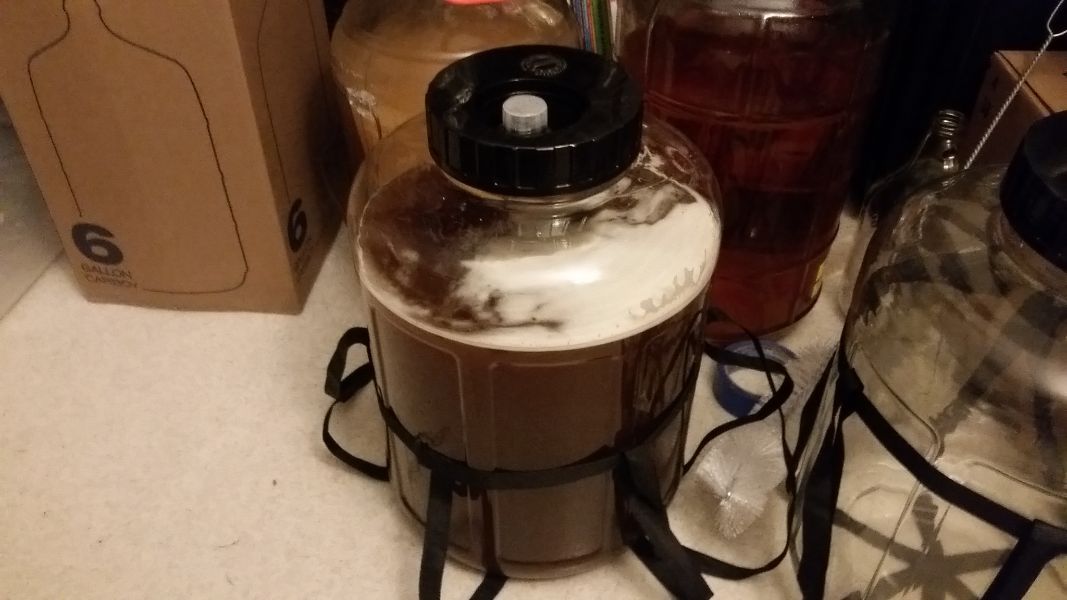First attempt at an Irish Red Ale.
Originally Posted: Aug. 5, 2020

Table of Contents
Quick Specs
- Est. OG = 1.056
- OG = 1.058 actual
- Est. FG = 1.014
- FG = 1.017 actual
- ABV: 5.4%
- Taste Profile: Malty and smooth
- Time: don’t ask, there were complications
- Yield: 1 Corny keg
Base Recipe
I took cues from two recipes I found online for this beer.
- Beer & Brewing’s “Kiss Me, I Brewed This” Irish red ale recipe: This provided the ingredients list.
- E.C. Kraus provides both an extract and all-grain version of an Irish red as well. The other recipe didn’t specify a °L rating for the Crystal malt, so I had to compare to a few other recipes and settled on this one.

Intro
I love a good Irish red ale, especially when the weather is cooler. In my younger days, my tastes in beer tended towards maltier brews, and this style fit the bill perfectly. Kilkenny is my favorite commercial example, it just pairs so well with some bangers and mash or sausage rolls at the local Irish pub.
When I first got my Grainfather, I decided to break it in with an attempt at Irish red ale. It seemed like it would be a simple beginner beer, so I found a few recipes online that looked promising and used them as a starting point. My brother was home from college at the time, so he came over to help out as well.

One thing I learned from this brew-day is that you should start early in the day if you’re unfamiliar with a new brewing system. Since that first time I’ve noticed that with the Grainfather, brew-day averages 4-6 hours.
After primary fermentation was done, I ended up leaving this beer in secondary for several months. I didn’t have any free time to work with my brews for a while, and I jokingly told people I was “letting it bulk age”. Another problem arose when I decided that I didn’t want to deal with cleaning 60+ bottles and decided to buy my first kegging system. Unfortunately, I didn’t have a kegerator or a refrigerator big enough to cool the entire batch down to a safe serving temperature, so it “bulk aged” once again in the keg for about three years. Amazingly, once I finally bought a kegerator and was able to serve this beer, it still tasted amazing. Never heard of that happening before with a low ABV beer, so maybe I just got lucky.

Ingredients
Malt
- 9 lbs Maris Otter or Golden Promise (my LHBS was out, so I subbed American 2-row)
- 1.75 lbs Flaked maize (adds creaminess, might experiment with rolled oats in the future)
- 1 lb Crystal malt 60°L
- 0.13 lbs Roasted barley
- Total weight: 11.88 lbs
Hops
- Kent Goldings
- 1.25oz @ 60min
- 0.75oz @ 5min
Yeast
Equipment
- Sanitizer
- Fermenter
- Airlock and stopper
- Brewing system of your choice
- Optional: I like to keep a spare cooler or basin around to stick the grain basket after sparging. This allows the spent grain to drain before you put it in the garbage or compost, and it’s easy to clean up after.

Instructions
- Mash at 150°F for 60 min.
- Boil for 60 min, follow hop schedule.
- Ferment for a few weeks, bottle or keg when finished.
- Note: I “accidentally” left this in the fermenter for a few months and then in the keg for a few years, and it was still delicious.

Specific to Grainfather
Mash water calc.: (Grain weight * 0.34) + 0.9gal = (11.88 * .34) + .9 = 4.94gal
Sparge water calc.: (6.4 – mash vol.) + (grain weight * 0.1) = (1.46) + (1.188) = 2.65gal
Tips & Tricks
This was my first use of the Grainfather. For the sparge water, I preheated 2.65 gal of water in batches in my electric kettle, then stored it in an insulated cooler with a spout. It was a hassle. The next time I brewed a beer rather than a cider or mead (it was a while), I decided I needed Grainfather’s sparge water heater. I’ve never regretted the purchase, it made everything so easy.
I also learned how long the American 110V version of the Grainfather can take to come to a full boil. We started the brew later than we should have, so once everything was finished and cleaned up, it was close to midnight. To help mitigate the time it took to get to a boil, I decided to purchase the Grainfather insulated jacket before my next brew-day.





